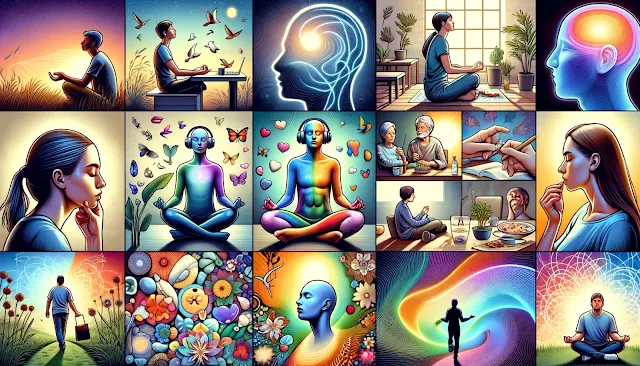 |
| Embrace tranquility in your busy life with these easy, quick mindfulness practices. From deep breathing to mindful walking, discover the art of living in the moment. |
1. One-Minute Breathing Exercise
This exercise can be done anywhere, anytime. Simply focus on your breathing for one full minute. Pay attention to the sensation of air entering and leaving your nostrils, or the rise and fall of your chest. This brief pause can significantly reduce stress and increase your focus.2. Mindful Observation
Choose an object within your sight and focus on it for a minute or two. This could be anything – a tree, a building, or even a coffee cup. Observe it as if you're seeing it for the first time. Notice its color, shape, and texture. This practice helps you reconnect with the present moment.3. Gratitude Moments
Spend a minute thinking about something you're grateful for. It could be as simple as a sunny day or a good meal. Gratitude increases positive emotions and can quickly shift your mindset.4. Mindful Listening
For a minute, close your eyes and focus on the sounds around you. Let go of the urge to label or judge the sounds and simply listen. This practice can heighten your auditory awareness and bring a sense of calm.5. Body Scan
Starting from the top of your head and moving down to your toes, pay attention to each part of your body for a few seconds. Notice any sensations, tension, or discomfort. This quick scan can help you become more attuned to physical sensations and relax tense areas.6. Mindful Eating
Take the first bite of your meal mindfully. Notice the texture, taste, and aroma of the food. Eating mindfully can enhance your dining experience and prevent overeating.7. Mindful Movement
Incorporate mindfulness into your physical activities. If you're walking, pay attention to the sensation of your feet touching the ground. If you're stretching, focus on how your muscles feel. This can deepen the connection between your body and mind.8. Mindful Affirmations
Take a moment to silently repeat a positive affirmation. It could be something like, "I am calm and centered." Affirmations can boost self-esteem and provide a quick mental reset.9. Visual Breathing
Visualize your breath as a color or shape moving in and out of your body. This can make the breathing exercise more engaging and calming.10. Mindful Savoring
Take a moment to savor a pleasant experience. It could be the warmth of the sun on your skin or a cool breeze. Absorbing these moments can significantly uplift your mood.Incorporating these quick mindfulness practices into your daily routine can lead to significant improvements in your mental well-being. Remember, mindfulness doesn't require special equipment or a lot of time; even a minute can make a difference. Embrace these brief practices and watch how they transform your busy life, bringing a sense of peace and clarity.
RELATED TOPICS
Health Triangle: Balancing Physical, Mental & Social Well-Being
Mental Health Strategies for Well-Being
Components of the Health Triangle
Physical Health vs. Mental Health vs. Social Health Explained
Importance of a Balanced Health Triangle for Overall Well-being
Healthy Lifestyle Choices for a Balanced Health Triangle: Achieving Balance
Disclaimer
This site offers a variety of informational content. Be aware that material on "Health Triangle" may not reflect the most current practices or data. Always verify the publication or update date. Importantly, no content here substitutes for professional medical advice. Consult a healthcare professional for personalized guidance and seek immediate help from a health institution or specialist for medical concerns.